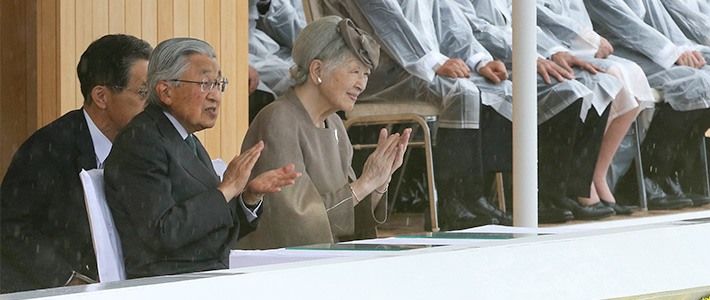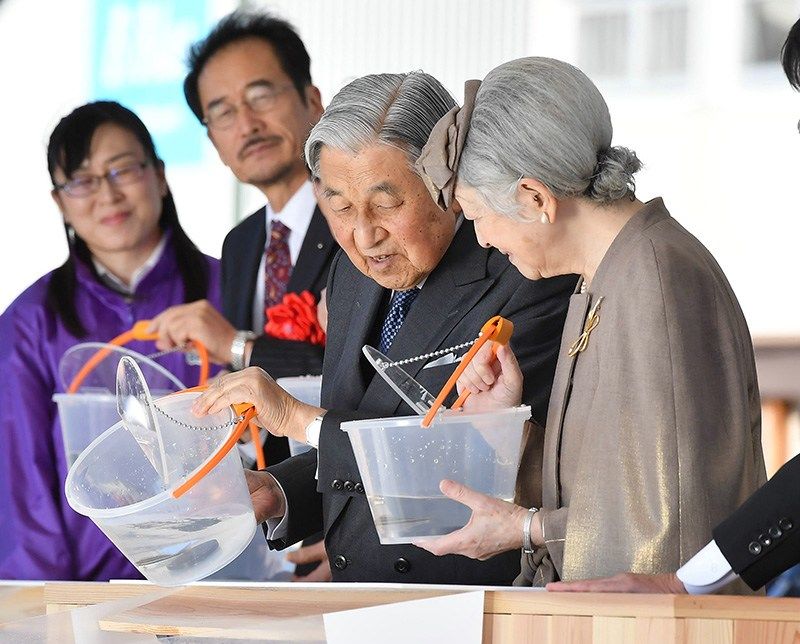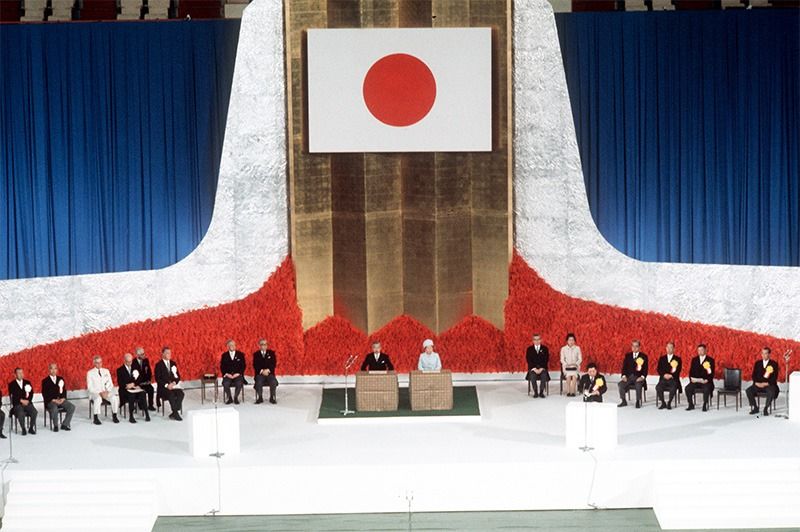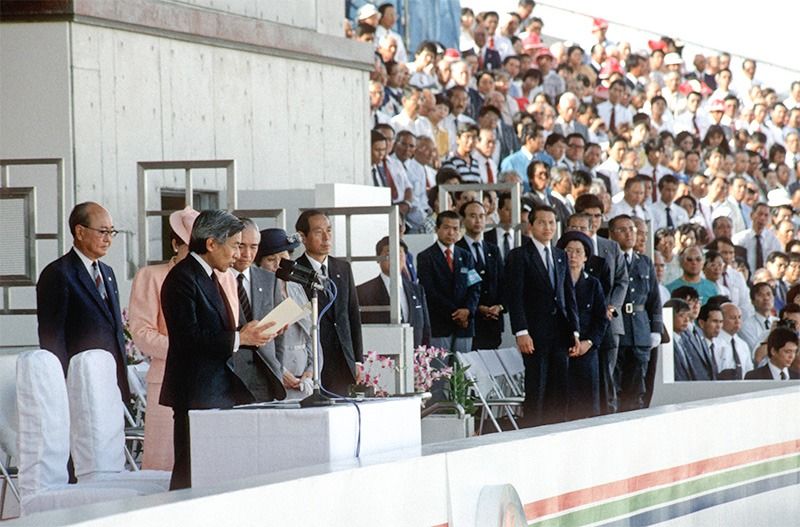
A New Era for Japan: Shōwa to Heisei to the Future
Imperial Visits and Okinawa
Society- English
- 日本語
- 简体字
- 繁體字
- Français
- Español
- العربية
- Русский
A Packed Schedule
With less than six months to go until the imperial succession, there has been no let-up in the schedule of Emperor Akihito and Empress Michiko. In September, they made visits to areas affected by flooding in Okayama, Ehime, and Hiroshima Prefectures, as well as attending the National Sports Festival in Fukui Prefecture. The next month the imperial couple went to Kōchi Prefecture for the Cherished Sea Festival, which promotes the country’s fisheries. Then in November, they visited earthquake-hit communities in Hokkaidō.
Emperor Akihito spoke of the importance of making visits through Japan in his August 2016 video message on his desire to abdicate. “In my travels throughout the country, which I have made together with the Empress, including the time when I was Crown Prince, I was made aware that wherever I went there were thousands of citizens who love their local community and with quiet dedication continue to support their community.”
The imperial visits are centered on three main events, which are held in different prefectures every year: the National Sports Festival, Cherished Sea Festival, and National Arbor Day Festival. Emperor Akihito and Empress Michiko spend a few days in each prefecture at the time of the events, which are valuable opportunities for meeting with the local people. The imperial couple’s travels around the country have brought them ever greater popularity.
When they arrived in Fukui Prefecture on September 28, some 4,000 local citizens welcomed the emperor and empress on the route to their hotel with lanterns. There were also lanterns in the hotel windows. Unfortunately, it was rainy the next day, but at the opening ceremony of the last National Sports Festival before the imperial succession, they waved to athletes from around the country as they entered the stadium.
On October 27, they went to Kōchi Prefecture for three days. Having attended the Cherished Sea Festival on October 28 in the city of Kōchi, they viewed a parade of fishing vessels in the harbor at Tosa and released grunt and striped beakfish fry into the sea. While Emperor Akihito took over attendance of the National Sports Festival and National Arbor Day Festival from his father Emperor Shōwa, he has been present at each Cherished Sea Festival since its inception in 1981, when he was still crown prince. It was established with the hope of revitalizing the sea after its decline due to overfishing and industrial pollution.
 Emperor Akihito and Empress Michiko release grunt fry into the sea at the Cherished Sea Festival in Tosa, Kōchi Prefecture, on October 28, 2018. (© Jiji)
Emperor Akihito and Empress Michiko release grunt fry into the sea at the Cherished Sea Festival in Tosa, Kōchi Prefecture, on October 28, 2018. (© Jiji)
From next year, the new emperor will take on responsibility for attending the three major events. To lighten the load of Emperor Akihito’s imperial duties, from 2009 he no longer gave an address at each event, but this custom is sure to be revived.
A Somber Season
Three decades earlier, in late 1988, Emperor Shōwa (Hirohito) was seriously ill and Japan was in a subdued mood. Many autumn and sports festivals were canceled, along with comedy and entertainment television programs, leaving more than a few citizens suffering from the onerous atmosphere. The kogarashi ichigō, or first wind of winter, was recorded as early as October 13 in Tokyo, and the country braced for a period of cold.
Nonetheless, the National Sports Festival kicked off on October 15, almost entirely according to schedule, apart from the cancelation of a fireworks display. The Imperial Household Agency did have to make some changes to the normal procedure. Kyoto was to become the first prefecture to host the event twice, and the initial plan was for the crown prince—now Emperor Akihito—to represent his father. The IHA decided, however, that he could not leave Tokyo at this time, so Emperor Shōwa’s grandson—now Crown Prince Naruhito—attended instead. He only saw the opening ceremony and some performances before immediately returning to Tokyo the same day.
A Fervent Desire to Visit Okinawa
In talking of Emperor Shōwa’s trips around the country in late life, one must mention the National Sports Festival held in Okinawa in October 1987. The prefecture was the site of a bloody World War II battle that resulted in the deaths of tens of thousands of soldiers and civilians. Emperor Shōwa’s last wish was to visit Okinawa, and as it became the final prefecture to host the sports festival, he had the opportunity to do so. An extended stay of five days and four nights was planned.
In a press conference before his eighty-sixth birthday in April of the same year, Emperor Shōwa said that he had always thought that he would have liked to have visited Okinawa on his postwar tour of Japan. A visit would allow him to honor the souls of the dead and show his respect for the long suffering of the people.
 Emperor Shōwa attends a ceremony in Tokyo in May 1972 to mark the reversion of Okinawa to Japan. (© Jiji)
Emperor Shōwa attends a ceremony in Tokyo in May 1972 to mark the reversion of Okinawa to Japan. (© Jiji)
Emperor Shōwa must have known that, due to the mixed feelings of the islands’ citizens, there was a movement opposing an imperial visit to Okinawa. When Crown Prince Akihito and Crown Princess Michiko made their first trip there 12 years earlier, a member of an extremist group threw a firebomb at them. Even so, Emperor Shōwa saw it as a final duty to pay his respects on the southern battlefield and to show his appreciation for the people of the prefecture, who had brought about a recovery from the damage of war.
Unfortunately, however, one month before the trip was scheduled to take place, the emperor underwent an operation on his intestine. When IHA Grand Steward Tomita Tomohiko told him of the trip’s cancelation, he murmured, “When will I be able to go there?”
I accompanied Crown Prince Akihito and Crown Princess Michiko, who traveled in his stead. At Okinawa Peace Hall in Mabuni, the crown prince on behalf of his father. “When I think of the great suffering undergone by the prefecture both during and after the war, I feel great sadness and pain.” Yet some of the Diet members scheduled to welcome him did not attend. A conspicuous number of people also remained silent and seated during the singing of the national anthem “Kimigayo” and the raising of the flag at the sports festival’s opening ceremony. Observing these scenes, by then rare in the rest of Japan, I felt the depth of the wounds left by the Battle of Okinawa. When I interviewed local people at the stadium and in the streets of Naha, these responses remained in my memory. “I wanted to hear the emperor say the words himself.” “I wanted to feel an end to it through direct words of sympathy from the emperor.”
 Crown Prince Akihito speaks on behalf of his father Emperor Shōwa at the National Sports Festival in Okinawa, Okinawa Prefecture, in October 1987. (© Jiji)
Crown Prince Akihito speaks on behalf of his father Emperor Shōwa at the National Sports Festival in Okinawa, Okinawa Prefecture, in October 1987. (© Jiji)
Emperor Shōwa never gave up on his wish of going to Okinawa, stating several times that he would visit there as soon as possible after making a recovery. While there was some discussion of a trip in spring 1988, six months after his operation, it never came to fruition, due to his poor health and security issues.
Ready for Whatever Is Necessary
Even then, the emperor’s attendants wanted to heed his earnest wish. Before he collapsed in September 1988, I spoke to his chief physician Takagi Akira about the possibility of a journey to Okinawa.
“Based on his physical condition, I think it’s impossible,” Takagi said, “But if his majesty really has a strong wish to go, I am ready to do whatever is necessary. I have considered that he could fly to Naha by airplane and then, to reduce the physical strain, he could take the helicopter he previously used for a visit to Izu Ōshima to reach the southern battlefield, where he could pay his respects and make a speech. Then he would return by helicopter to Naha. That way he could complete the trip in a single day.”
This bold plan was never realized, but it somewhat resembles the journey made by Emperor Akihito in September this year. When the emperor made a one-day trip to areas affected by flooding in Ehime and Hiroshima Prefectures, he crossed there and back across the Seto Inland Sea by helicopter.
Remember the Battle of Okinawa
Emperor Akihito also has strong feelings for Okinawa, and has made 11 visits in total since he was crown prince. He has described the date of the Battle of Okinawa, June 23, as one of four that Japanese cannot forget, alongside those of the end of World War II and the atomic bombings of Hiroshima and Nagasaki. It is also well known that he has taught this to his children.
At a 1996 press conference, Emperor Akihito said, “I hope that Okinawa’s problems will be thoroughly discussed by the Japanese and US governments, and that a path will open to a solution that can bring happiness to its citizens.” As he generally avoids political proclamations, his mention of the two countries’ governments demonstrates his powerful feelings. Following the previous year’s rape of a local schoolgirl by three American soldiers, 89% of voters in a local referendum had agreed that there should be a reduction of the US military presence in Okinawa.
Emperor Akihito also touched on how Okinawa had remained under US jurisdiction for two more decades after the Occupation ended in the rest of the country in 1952. “I believe it is the duty of other Japanese to be aware of Okinawa’s history and how its people worked toward reversion to Japan.” I understand this as the emperor’s call of encouragement to his citizens.
In the last autumn of the Heisei era, Okinawa held a gubernatorial election. This prefecture, about which two emperors felt great heartache, is still in an uproar over the bases issue.
(Originally published in Japanese on November 7, 2018. Banner photo: Emperor Akihito and Empress Michiko attend the opening festival of the National Sports Festival in Fukui, Fukui Prefecture, on September 29, 2018. © Jiji.)